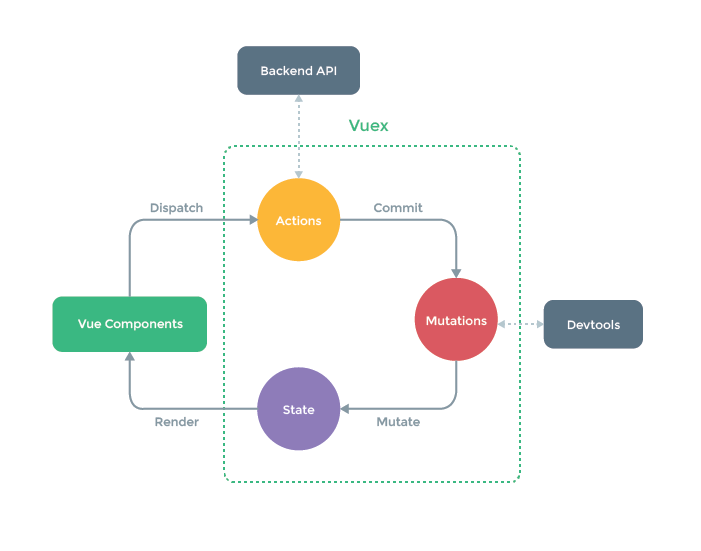vuex
Vuex 是一个专为 Vue.js 应用程序开发的状态管理模式。它采用集中式存储管理应用的所有组件的状态,并以相应的规则保证状态以一种可预测的方式发生变化。Vuex 也集成到 Vue 的官方调试工具 devtools extension,提供了诸如零配置的 time-travel 调试、状态快照导入导出等高级调试功能。
什么是“状态管理模式”?

- state,驱动应用的数据源;
- view,以声明方式将 state 映射到视图;
- actions,响应在 view 上的用户输入导致的状态变化。
但是,当我们的应用遇到多个组件共享状态时,单向数据流的简洁性很容易被破坏:
- 多个视图依赖于同一状态。
- 来自不同视图的行为需要变更同一状态。
因此我们把组件的共享状态抽取出来,以一个全局单例模式管理。我们的组件树构成了一个巨大的“视图”,不管在树的哪个位置,任何组件都能获取状态或者触发行为。
通过定义和隔离状态管理中的各种概念并强制遵守一定的规则,我们的代码将会变得更结构化且易维护。
当我们需要构建一个中大型单页应用,为了更好地在组件外部管理状态,Vuex 将会成为自然而然的选择。
Store
每一个 Vuex 应用的核心就是 store(仓库)
Vuex 和单纯的全局对象有以下两点不同:
-
Vuex 的状态存储是响应式的。当 Vue 组件从 store 中读取状态的时候,若 store 中的状态发生变化,那么相应的组件也会相应地得到高效更新。
-
你不能直接改变 store 中的状态。改变 store 中的状态的唯一途径就是显式地提交 (commit) mutation。这样使得我们可以方便地跟踪每一个状态的变化,从而让我们能够实现一些工具帮助我们更好地了解我们的应用。
// 如果在模块化构建系统中,请确保在开头调用了 Vue.use(Vuex) const store = new Vuex.Store({ state: { count: 0 }, mutations: { increment (state) { state.count++ } } })
可以通过 store.state 来获取状态对象,以及通过 store.commit 方法触发状态变更:
store.commit('increment') console.log(store.state.count) // -> 1
我们通过提交 mutation 的方式,而非直接改变 store.state.count,这样我们想可以更明确地追踪到状态的变化。
store 中的状态是响应式的,在组件中调用 store 中的状态简单到仅需要在计算属性中返回即可。触发变化也仅仅是在组件的 methods 中提交 mutation。
核心概念
State
单一状态树
Vuex 使用单一状态树,一个对象就包含了全部的应用层级状态。state作为一个“唯一数据源。这也意味着,每个应用将仅仅包含一个 store 实例。单一状态树让我们能够直接地定位任一特定的状态片段,在调试的过程中也能轻易地取得整个当前应用状态的快照。
在 Vue 组件中获得 Vuex 状态
// 创建一个 Counter 组件 const Counter = { template: `<div>{{ count }}</div>`, computed: { count () { return store.state.count } } }
每当 store.state.count 变化的时候, 都会重新求取计算属性,并且触发更新相关联的 DOM。
然而,这种模式导致组件依赖全局状态单例。在模块化的构建系统中,在每个需要使用 state 的组件中需要频繁地导入,并且在测试组件时需要模拟状态。
Vuex 通过 store 选项,提供了一种机制将状态从根组件“注入”到每一个子组件中(需调用 Vue.use(Vuex)):
const app = new Vue({ el: '#app', // 把 store 对象提供给 “store” 选项,这可以把 store 的实例注入所有的子组件 store, components: { Counter }, template: ` <div class="app"> <counter></counter> </div> ` })
通过在根实例中注册 store 选项,该 store 实例会注入到根组件下的所有子组件中,且子组件能通过 this.$store 访问到。让我们更新下 Counter 的实现:
const Counter = { template: `<div>{{ count }}</div>`, computed: { count () { return this.$store.state.count } } }
mapState 辅助函数
当一个组件需要获取多个状态时候,将这些状态都声明为计算属性会有些重复和冗余。为了解决这个问题,我们可以使用 mapState 辅助函数帮助我们生成计算属性,可以少按几次键:
// 在单独构建的版本中辅助函数为 Vuex.mapState import { mapState } from 'vuex' export default { // ... computed: mapState({ // 箭头函数可使代码更简练 count: state => state.count, // 传字符串参数 'count' 等同于 `state => state.count` countAlias: 'count', // 为了能够使用 `this` 获取局部状态,必须使用常规函数 countPlusLocalState (state) { return state.count + this.localCount } }) }
当映射的计算属性的名称与 state 的子节点名称相同时,我们也可以给 mapState 传一个字符串数组。
computed: mapState([ // 映射 this.count 为 store.state.count 'count' ])
对象展开运算符
我们需要使用一个工具函数将多个对象合并为一个,以使我们可以将最终对象传给 computed 属性。
computed: { localComputed () { /* ... */ }, // 使用对象展开运算符将此对象混入到外部对象中 ...mapState({ // ... }) }
组件仍然保有局部状态
如果有些状态严格属于单个组件,最好还是作为组件的局部状态。虽然将所有的状态放到 Vuex 会使状态变化更显式和易调试,但也会使代码变得冗长和不直观。
Getter
Vuex 允许我们在 store 中定义“getter”(可以认为是 store 的计算属性)。就像计算属性一样,getter 的返回值会根据它的依赖被缓存起来,且只有当它的依赖值发生了改变才会被重新计算。
Getter 接受 state 作为其第一个参数:
const store = new Vuex.Store({ state: { todos: [ { id: 1, text: '...', done: true }, { id: 2, text: '...', done: false } ] }, getters: { doneTodos: state => { return state.todos.filter(todo => todo.done) } } })
通过属性访问
Getter 会暴露为 store.getters 对象,可以以属性的形式访问这些值:
store.getters.doneTodos // -> [{ id: 1, text: '...', done: true }]
Getter 也可以接受其他 getter 作为第二个参数:
getters: { // ... doneTodosCount: (state, getters) => { return getters.doneTodos.length } }
store.getters.doneTodosCount // -> 1我们可以很容易地在任何组件中使用它:
computed: { doneTodosCount () { return this.$store.getters.doneTodosCount } }
注意,getter 在通过属性访问时是作为 Vue 的响应式系统的一部分缓存其中的。
通过方法访问
也可以通过让 getter 返回一个函数,来实现给 getter 传参。对 store 里的数组进行查询时非常有用。
getters: { // ... getTodoById: (state) => (id) => { return state.todos.find(todo => todo.id === id) } }
store.getters.getTodoById(2) // -> { id: 2, text: '...', done: false }注意,getter 在通过方法访问时,每次都会去进行调用,而不会缓存结果。
mapGetters 辅助函数
mapGetters 辅助函数仅仅是将 store 中的 getter 映射到局部计算属性:
import { mapGetters } from 'vuex'
export default {
// ...
computed: {
// 使用对象展开运算符将 getter 混入 computed 对象中
...mapGetters([
'doneTodosCount',
'anotherGetter',
// ...
])
}
}
如果想将一个 getter 属性另取一个名字,使用对象形式:
mapGetters({ // 把 `this.doneCount` 映射为 `this.$store.getters.doneTodosCount` doneCount: 'doneTodosCount' })
Mutation
更改 Vuex 的 store 中的状态的唯一方法是提交 mutation。Vuex 中的 mutation 非常类似于事件:每个 mutation 都有一个字符串的 事件类型 (type) 和 一个 回调函数 (handler)。这个回调函数就是我们实际进行状态更改的地方,并且它会接受 state 作为第一个参数:
const store = new Vuex.Store({ state: { count: 1 }, mutations: { increment (state) { // 变更状态 state.count++ } } })
这个选项是事件注册:“当触发一个类型为 increment 的 mutation 时,调用此函数。”要唤醒一个 mutation handler,需要以相应的 type 调用 store.commit 方法:
store.commit('increment')
提交载荷(Payload)
可以向 store.commit 传入额外的参数,即 mutation 的 载荷(payload):
// ... mutations: { increment (state, n) { state.count += n } } store.commit('increment', 10)
在大多数情况下,载荷应该是一个对象,这样可以包含多个字段并且记录的 mutation 会更易读:
// ... mutations: { increment (state, payload) { state.count += payload.amount } }
store.commit('increment', {
amount: 10
})对象风格的提交方式
提交 mutation 的另一种方式是直接使用包含 type 属性的对象:
store.commit({ type: 'increment', amount: 10 })
当使用对象风格的提交方式,整个对象都作为载荷传给 mutation 函数,因此 handler 保持不变:
mutations: { increment (state, payload) { state.count += payload.amount } }
Mutation 需遵守 Vue 的响应规则
既然 Vuex 的 store 中的状态是响应式的,那么当变更状态时,监视状态的 Vue 组件也会自动更新。这也意味着 Vuex 中的 mutation 也需要与使用 Vue 一样遵守一些注意事项:
-
最好提前在store 中初始化好所有所需属性。
-
当需要在对象上添加新属性时,应该
-
使用
Vue.set(obj, 'newProp', 123), 或者 -
以新对象替换老对象。例如,利用 stage-3 的对象展开运算符我们可以这样写:
state.obj = { ...state.obj, newProp: 123 }
使用常量替代 Mutation 事件类型
使用常量替代 mutation 事件类型在各种 Flux 实现中是很常见的模式。这样可以使 linter 之类的工具发挥作用,同时把这些常量放在单独的文件中可以让代码合作者对整个 app 包含的 mutation 一目了然:
// mutation-types.js export const SOME_MUTATION = 'SOME_MUTATION'
// store.js import Vuex from 'vuex' import { SOME_MUTATION } from './mutation-types' const store = new Vuex.Store({ state: { ... }, mutations: { // 我们可以使用 ES2015 风格的计算属性命名功能来使用一个常量作为函数名 [SOME_MUTATION] (state) { // mutate state } } })
Mutation 必须是同步函数
Action
Action 类似于 mutation,不同在于:
- Action 提交的是 mutation,而不是直接变更状态。
- Action 可以包含任意异步操作。
const store = new Vuex.Store({ state: { count: 0 }, mutations: { increment (state) { state.count++ } }, actions: { increment (context) { context.commit('increment') } } })
Action 函数接受一个与 store 实例具有相同方法和属性的 context 对象,因此可以调用 context.commit 提交一个 mutation,或者通过 context.state 和 context.getters 来获取 state 和 getters。
实践中,会经常用到 ES2015 的 参数解构 来简化代码(特别是需要调用 commit 很多次的时候):
actions: { increment ({ commit }) { commit('increment') } }
分发 Action
Action 通过 store.dispatch 方法触发:
store.dispatch('increment')
Action 就不受同步执行这个约束!可以在 action 内部执行异步操作:
actions: { incrementAsync ({ commit }) { setTimeout(() => { commit('increment') }, 1000) } }
Actions 支持同样的载荷方式和对象方式进行分发:
// 以载荷形式分发 store.dispatch('incrementAsync', { amount: 10 }) // 以对象形式分发 store.dispatch({ type: 'incrementAsync', amount: 10 })
在组件中分发 Action
在组件中使用 this.$store.dispatch('xxx') 分发 action,或者使用 mapActions 辅助函数将组件的 methods 映射为 store.dispatch 调用(需要先在根节点注入 store):
import { mapActions } from 'vuex'
export default {
// ...
methods: {
...mapActions([
'increment', // 将 `this.increment()` 映射为 `this.$store.dispatch('increment')`
// `mapActions` 也支持载荷:
'incrementBy' // 将 `this.incrementBy(amount)` 映射为 `this.$store.dispatch('incrementBy', amount)`
]),
...mapActions({
add: 'increment' // 将 `this.add()` 映射为 `this.$store.dispatch('increment')`
})
}
}
组合 Action
store.dispatch 可以处理被触发的 action 的处理函数返回的 Promise,并且 store.dispatch 仍旧返回 Promise:
actions: { actionA ({ commit }) { return new Promise((resolve, reject) => { setTimeout(() => { commit('someMutation') resolve() }, 1000) }) } }
store.dispatch('actionA').then(() => {
// ...
})
在另外一个 action 中也可以:
actions: { // ... actionB ({ dispatch, commit }) { return dispatch('actionA').then(() => { commit('someOtherMutation') }) } }
如果我们利用 async/await,可以如下组合 action:
// 假设 getData() 和 getOtherData() 返回的是 Promise actions: { async actionA ({ commit }) { commit('gotData', await getData()) }, async actionB ({ dispatch, commit }) { await dispatch('actionA') // 等待 actionA 完成 commit('gotOtherData', await getOtherData()) } }
一个 store.dispatch 在不同模块中可以触发多个 action 函数。在这种情况下,只有当所有触发函数完成后,返回的 Promise 才会执行。
Module
Vuex 允许我们将 store 分割成模块(module)。每个模块拥有自己的 state、mutation、action、getter、甚至是嵌套子模块——从上至下进行同样方式的分割:
const moduleA = { state: { ... }, mutations: { ... }, actions: { ... }, getters: { ... } } const moduleB = { state: { ... }, mutations: { ... }, actions: { ... } } const store = new Vuex.Store({ modules: { a: moduleA, b: moduleB } }) store.state.a // -> moduleA 的状态 store.state.b // -> moduleB 的状态
模块的局部状态
对于模块内部的 mutation 和 getter,接收的第一个参数是模块的局部状态对象。
const moduleA = { state: { count: 0 }, mutations: { increment (state) { // 这里的 `state` 对象是模块的局部状态 state.count++ } }, getters: { doubleCount (state) { return state.count * 2 } } }
同样,对于模块内部的 action,局部状态通过 context.state 暴露出来,根节点状态则为 context.rootState:
const moduleA = { // ... actions: { incrementIfOddOnRootSum ({ state, commit, rootState }) { if ((state.count + rootState.count) % 2 === 1) { commit('increment') } } } }
对于模块内部的 getter,根节点状态会作为第三个参数暴露出来:
const moduleA = { // ... getters: { sumWithRootCount (state, getters, rootState) { return state.count + rootState.count } } }
命名空间
默认情况下,模块内部的 action、mutation 和 getter 是注册在全局命名空间的——这样使得多个模块能够对同一 mutation 或 action 作出响应。
通过添加 namespaced: true 的方式使其成为带命名空间的模块,可以使模块具有更高的封装度和复用性。
在带命名空间的模块内访问全局内容(Global Assets)
如果你希望使用全局 state 和 getter,rootState 和 rootGetter 会作为第三和第四参数传入 getter,也会通过 context 对象的属性传入 action。
若需要在全局命名空间内分发 action 或提交 mutation,将 { root: true } 作为第三参数传给 dispatch 或 commit 即可。
dispatch('someOtherAction', null, { root: true })
commit('someMutation', null, { root: true })在带命名空间的模块注册全局 action
若需要在带命名空间的模块注册全局 action,你可添加 root: true,并将这个 action 的定义放在函数 handler 中。例如:
{ actions: { someOtherAction ({dispatch}) { dispatch('someAction') } }, modules: { foo: { namespaced: true, actions: { someAction: { root: true, handler (namespacedContext, payload) { ... } // -> 'someAction' } } } } }
带命名空间的绑定函数
当使用 mapState, mapGetters, mapActions 和 mapMutations 这些函数来绑定带命名空间的模块时,写起来可能比较繁琐:
computed: { ...mapState({ a: state => state.some.nested.module.a, b: state => state.some.nested.module.b }) }, methods: { ...mapActions([ 'some/nested/module/foo', 'some/nested/module/bar' ]) }
对于这种情况,可以将模块的空间名称字符串作为第一个参数传递给上述函数,这样所有绑定都会自动将该模块作为上下文。于是上面的例子可以简化为:
computed: { ...mapState('some/nested/module', { a: state => state.a, b: state => state.b }) }, methods: { ...mapActions('some/nested/module', [ 'foo', 'bar' ]) }
而且,可以通过使用 createNamespacedHelpers 创建基于某个命名空间辅助函数。它返回一个对象,对象里有新的绑定在给定命名空间值上的组件绑定辅助函数:
import { createNamespacedHelpers } from 'vuex'
const { mapState, mapActions } = createNamespacedHelpers('some/nested/module')
export default {
computed: {
// 在 `some/nested/module` 中查找
...mapState({
a: state => state.a,
b: state => state.b
})
},
methods: {
// 在 `some/nested/module` 中查找
...mapActions([
'foo',
'bar'
])
}
}
给插件开发者的注意事项
如果开发的查件(Plugin)提供了模块并允许用户将其添加到 Vuex store,可能需要考虑模块的空间名称问题。对于这种情况,你可以通过插件的参数对象来允许用户指定空间名称:
// 通过插件的参数对象得到空间名称 // 然后返回 Vuex 插件函数 export function createPlugin (options = {}) { return function (store) { // 把空间名字添加到插件模块的类型(type)中去 const namespace = options.namespace || '' store.dispatch(namespace + 'pluginAction') } }
模块动态注册
在 store 创建之后,可以使用 store.registerModule 方法注册模块:
// 注册模块 `myModule` store.registerModule('myModule', { // ... }) // 注册嵌套模块 `nested/myModule` store.registerModule(['nested', 'myModule'], { // ... })
之后就可以通过 store.state.myModule 和 store.state.nested.myModule 访问模块的状态
模块动态注册功能使得其他 Vue 插件可以通过在 store 中附加新模块的方式来使用 Vuex 管理状态。例如,vuex-router-sync插件就是通过动态注册模块将 vue-router 和 vuex 结合在一起,实现应用的路由状态管理。
也可以使用 store.unregisterModule(moduleName) 来动态卸载模块。注意,不能使用此方法卸载静态模块(即创建 store 时声明的模块)。
在注册一个新 module 时,很有可能想保留过去的 state,例如从一个服务端渲染的应用保留 state。可以通过 preserveState 选项将其归档:store.registerModule('a', module, { preserveState: true })。
模块重用
- 创建多个 store,他们公用同一个模块 (例如当
runInNewContext选项是false或'once'时,为了在服务端渲染中避免有状态的单例) - 在一个 store 中多次注册同一个模块
如果使用一个纯对象来声明模块的状态,那么这个状态对象会通过引用被共享,导致状态对象被修改时 store 或模块间数据互相污染的问题。
实际上这和 Vue 组件内的 data 是同样的问题。因此解决办法也是相同的——使用一个函数来声明模块状态(仅 2.3.0+ 支持):
const MyReusableModule = { state () { return { foo: 'bar' } }, // mutation, action 和 getter 等等... }




